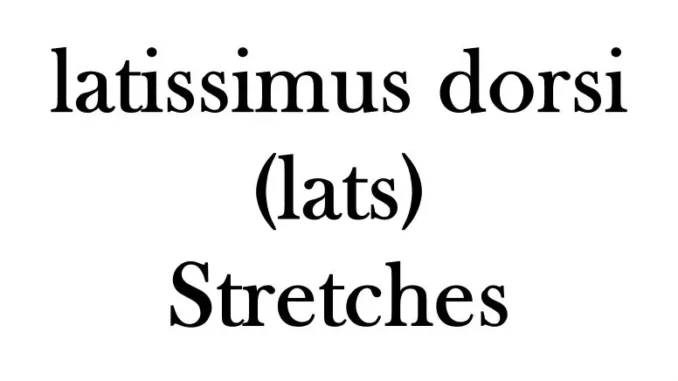
It is best to do lat stretches because this muscle plays an important role in the movement of our shoulder as well as for its health, you may feel like your lats (latissimus dorsi) are stiff or tight this can happen to your lats after an injury, surgery, lack of movement or overuse of lats. The latissimus dorsi extends from your shoulder to lower back and the main purpose of your lat is to protect your spine while also supporting your shoulder and back by providing the necessary strength. The latissimus dorsi is one of the biggest muscles in your body.
You may not know this but you’re using your lats more than you know for example lifting bags from the floor or pushing something.
Why you should stretch your lats?
Whenever you’re in the gym you have mostly seen people stretch their chest, hand, and legs but never lats, and it is weird because it’s very commonly tight muscle, especially among bodyweight athletes and it may look like a small thing but it can hold people back in overhead mobility since bodyweight athletes require overhead mobility for most exercises.
It’s important to stretch your lats because lats support your shoulder and arm movement and provide the necessary strength to them, lat stretches will help you strengthen and stretch your lats that in turn will increase your upper body strength and will also improve your range of motion while reducing your chances of suffering from injury.
Having stiff or tight lats can seriously decrease your overhead mobility it will be a very serious problem for someone that requires overhead mobility like lifters, swimmers, gymnasts, and many others. To unlock good overhead mobility lat stretches are included in many workout programs because stretches keep the muscles strong, healthy, and flexible, also we need muscle flexibility without it our muscles start to shrink and become tight that in turn restricts your movements.
Most people know how to stretch some of the muscles but when it comes to stretching the muscle that is connecting to the multiple joints and multiple muscles in our body, it’s a totally different case. To get the best result out of your stretch you need to know the starting point and the ending point of the muscle like to maximize the result of your stretch you have to create tension at various joints like the inferior angle of the scapula, Iliac Crest (top portion of hip bone), etc.
Lat stretches
All these exercises require equipment and some don’t, two of these exercises are yoga stretches, they are easy to do and can be done anywhere as long as you have some space to move freely.
Before we get into the exercises for lat stretches, you need to know there are two types of stretches…
Static stretching – Static stretching means holding a position for a particular period of time, this type of stretching comes into the mind of most people whenever they think f stretching, the purpose of static stretching is to relax your muscles.
Dynamic Stretching – Dynamic stretching involves continuous movement of the muscle like knees to the chest or jumping jacks. Dynamic stretching is mostly done before the workout to warm up your muscles.
Point to keep in mind before stretching
- Pain is not always good – You should feel a mild tension as your muscles stretches, but never pain. If you feel pain, stop right away. You’re overstretching and unintentionally hurting yourself when you overstretch a particular muscle group that muscle group sends a message via neuron to the central nervous system that you’re at your limit which causes those muscle to tighten and resist which in turn causes pain. It should be like a relaxing massage for your body, not pain.
- Posture – There isn’t much that you need to keep in mind when it comes to posture. Just do these simple things like spine straight, core engaged, that’s it.
- Breathe – Steady breathing is necessary doesn’t matter what you’re doing. So don’t hold your breath you’re depriving your muscle of getting oxygenated blood. So breathing will help relieve stress and tension in your muscles, it may also improve the quality of your stretching session, and who doesn’t like progress?
- Start slowly – Don’t go overboard with stretching, try not to do too much if it’s your first time stretching after a workout. Start with just a few basic stretches, and add more repetitions and stretches as you get used to them, and gradually progress.
- Child pose
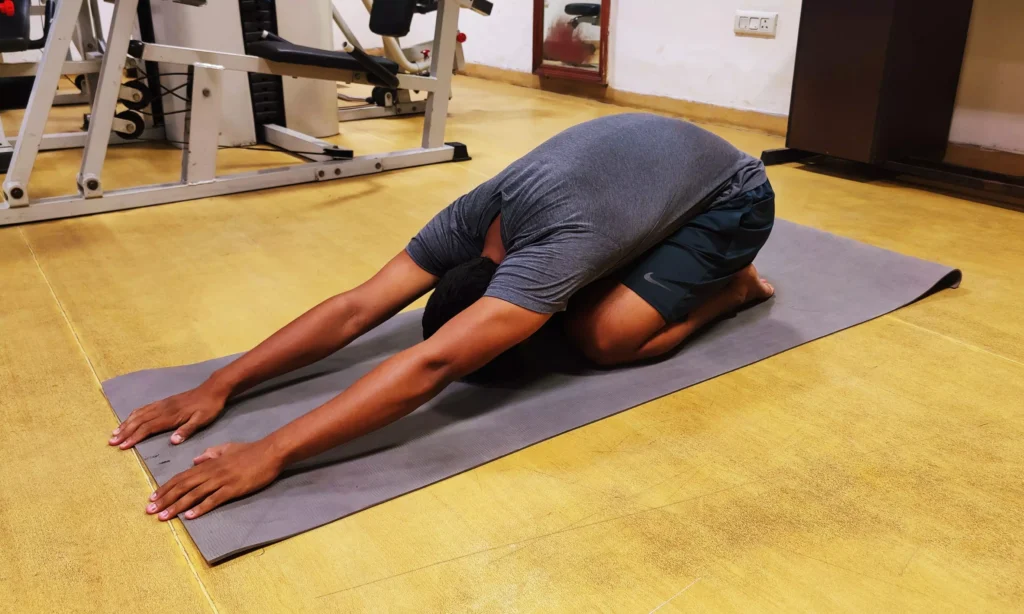
Child pose can help you stretch your lats not only that it also helps you to stretch the spine, neck, and shoulder. Child pose is a passive stretch. Child pose can also help you lengthen and strengthen your spine.
- Sit on the floor with your toes together, and your keens should be hip-width apart.
- Your hips will be resting on ankle, rest your palms on top of your thighs.
- Exhale, and start lowering your torso and start extending your arms along with lowering of your torso.
- Now your palm should be facing down, and relax your shoulders and fall onto the ground.
- Rest in that pose for as long as you want or for atleast 30 seconds to 1 minute.
2. Cat- cow pose
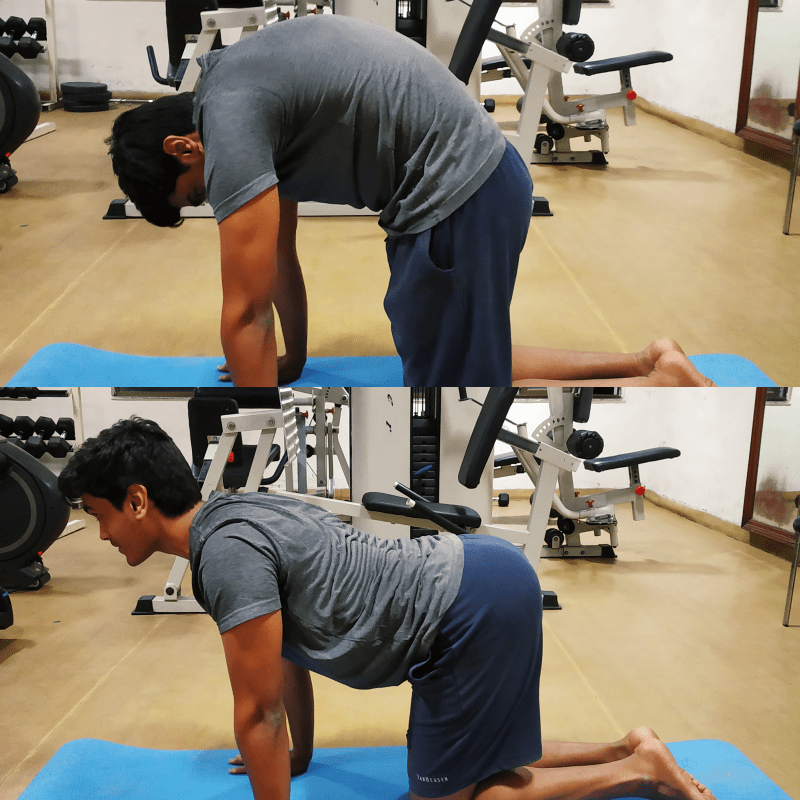
Cat- cow pose is said to improve your posture and body balance and act as a medicine for people suffering from back pain. Pairing a cat-cow pose with slow steady breathing can help you relax your mind and put your muscles at ease. When the cat-cow pose is done to its full extent it can also help you release tension from your neck.
- To get into the starting position your wrist should be directly underneath the shoulders, and knees should fall directly under hips with visualizing that your spine is in a straight line.
- Take a deep breath, bring your chest forward by dropping your belly down, your spine will form an arch, and try looking at the ceiling without over-extending your neck. This is a cow pose.
- As you exhale bring back your belly to the starting position and push your spine towards the ceiling by rounding your back and allow your head to fall towards the floor in a relaxed position you will be able to look at your navel. This is a cat pose.
- You will also notice a change in the movement of your shoulder blade as you bring your neck up for cow pose and down for cat pose.
- Repeat this cat-cow movement by inhaling and exhaling at least 6 to 8 times.
3. Butcher’s block
For this exercise, you need a dowel or a rod, or a broomstick handle that will also do the trick. Butcher’s block is just not another lat stretches it will also stretch your triceps and shoulder to a good extent. You also need an elevated surface that is not hard to find it can be your bed, gym bench, or wall.
- To get into the butcher’s block position you will be on your knees and your elbow will be resting on the elevated surface.
- Now we’re going to grab the rode with the grip that is slightly wider than the position of the elbow, we’ll be using a supinated grip and your hand should be fully extended.
- Make sure your spine forms a straight line with the elevated surface.
- Don’t arch your back, keep your body in a hollow position to get the proper stretch.
- Now with a tight supinated grip lift your arm and bring it over your head towards the back, make sure you don’t lift your elbow from the ground.
- While the dowel is over your head close to your back you can either hold that position for 20 to 30 seconds or bring the dowel back and forth slowly by adding movement to it and doing 10 reps.
It is tough to say if the hold is better or movement, do both and find out which variation works best for you and stretches your lats.
4. Horizontal pull
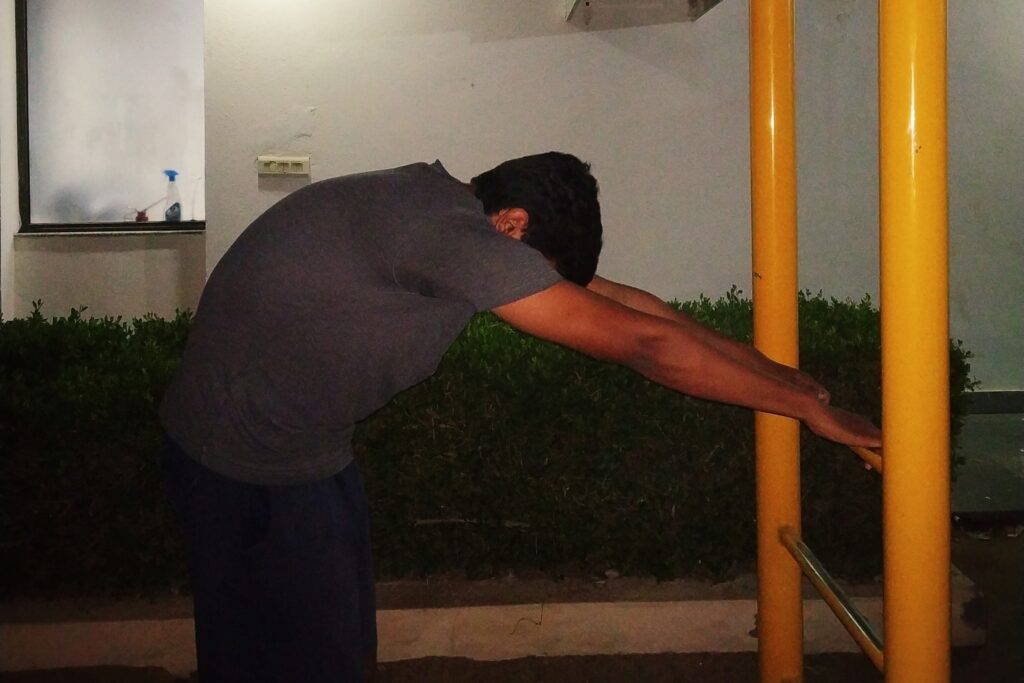
The horizontal pull will target all of your posterior chain as well as the lats you will be feeling the stretch on a little bit lower side of your latissimus dorsi. Horizontal pull movement will look like you’re doing single arm cable rows only difference would be you will be pushing your weight back while holding onto the stationary object.
- To perform a horizontal pull, you’ll simply need something to grab onto like a stationary object like a door handle or fixed single standing bar.
- The grip should be at hip height or a little bit higher than the hip.
- You can use a supinated or pronated grip, all you have to do is tight hold onto whatever object you’re pulling.
- Your feet should be planted at a meter or half a meter away from whatever that you’re pulling.
- Now just simply sit back with your feet and grip in the position and you’ll feel the stretch in the lats.
- Hold this position for at least 30 seconds.
While you can use both grips, I prefer to use a supinated grip because this helps you to increase the tension on your lats while stretching. If you want to intensify the stretch from horizontal pull you can try doing this stretch with one arm.
5. Active Elongate stretch
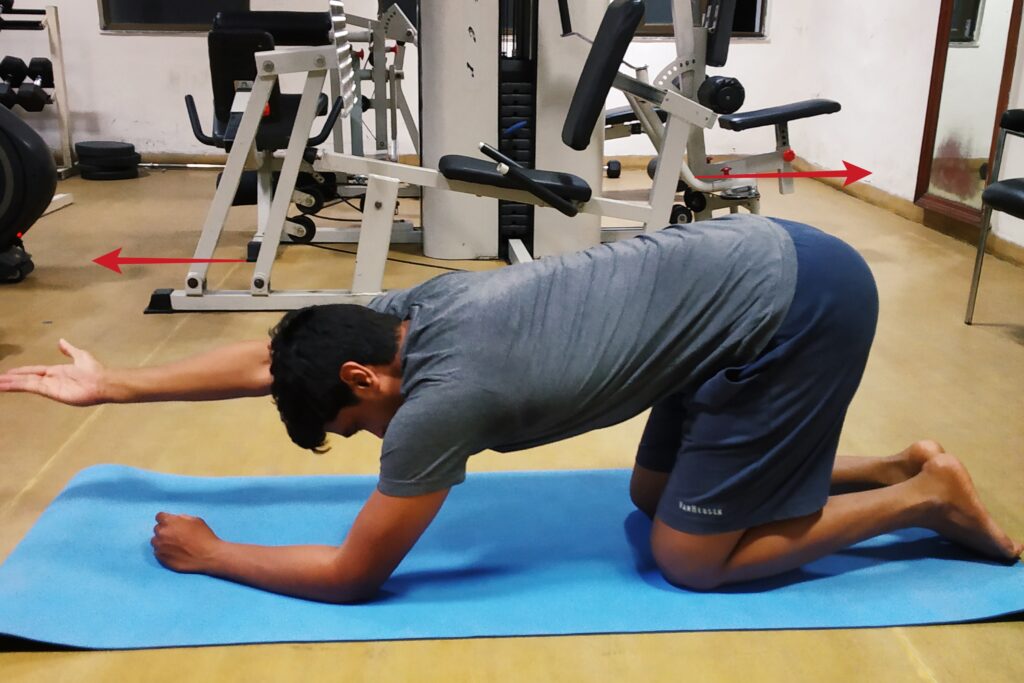
Doing passive lat stretches is good but you need to add some active lat stretches also in your workout to completely unlock overhead mobility. It doesn’t matter if you’re doing passive lat stretches but if you don’t include active lat stretches you will only see half the results. This is an active lat stretch exercise and also one of the easiest to do.
- To get into the starting position, you will be sitting on your knees and your elbow will be planted shoulder-width apart on the ground.
- Make sure your spine is straight and now try to fully extend your right arm more like pushing your right arm forward.
- While you’re extending your right arm forward at the same time try pushing your torso backward.
- Your arm and torso will be working against each other.
- As your arm is extending try rotating your hand so that your palm faces the ceiling.
- Hold that position for at least 5 to 10 seconds and bring your arm back, repeat the same movement with the other arm.
Final words
Doing all these lat stretches exercises a few times a week can help you a lot in achieving flexibility, reducing your pain due to tight lats, and also increasing your range of motion. These lat stretches will help you feel better while also strengthening your lats. If you feel pain while performing any of these lat stretches you should stop and give a visit to your doctor. If you have shoulder pain, lower back pain, or pain in your calves these exercises can help you get better.